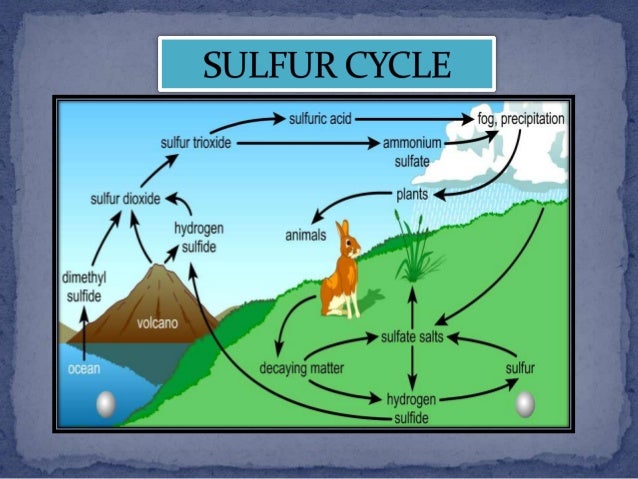The Sulfur Cycle 1/20/18
Summary:
This week in science we learned about biogeochemical cycles, more specifically, I learned about the biogeochemical cycle known as the Sulfur Cycle. What I now know about the Sulfur Cycle because of what I learned this week through research is each part in the sulfur cycle. I also now know that their are a lot of different parts in the sulfur, but my focus was trying to make this complicated cycle very simple and easy to understand. The first part in the Sulfur Cycle is Hydrogen Sulfide Gas is released into the atmosphere by the eruptions of volcanoes, hot springs (“spring produced by the emergence of geothermally heated groundwater that rises from the Earth's crust.”), and the decay of living biological sulfur-containing materials in swamps, bogs, and tidal flats. Sulfur is also released from the ocean in sulfur-containing compounds in sea spray, and as the gas hydrogen sulfide. I also know that most of the sulfur released from the world's oceans does so in the form of strong smelling sulfur compounds such as dimethyl sulfide. The next part in the Sulfur Cycle is When fossil fuels (coal, oil, and natural gases) are burned they release sulfur dioxide into the atmosphere. Sulfur dioxide and atmospheric oxygen react with each other to produce sulfur trioxide. The chemical formula of this reaction is 2SO2(g) + O2(g) -> 2SO3(g). I also know the last three parts of the Sulfur Cycle. The third to last part of the Sulfur Cycle is when decay (of animals) occurs in an environment without oxygen, “anaerobic oxygen break down hydrogen sulfide and release sulfur gas.” The next part is Oxygen-requiring bacteria can incorporate sulfur into sulfate salts/sulfates, which can be taken up by plants and enter the food chain once again.” Sulfur eventually falls to the bottom of the ocean in sediments. The next and last part of the Sulfur Cycle is Much later (from the part before), geological activity brings sulfur back to Earth’s surface. Weathering releases sulfur from surface rocks, making it available to terrestrial communities. The sulfur from rocks can also be released through volcanic activity. “Like most other nutrients with atmospheric cycles, sulfur cycles through terrestrial and aquatic systems relatively quickly."
This week I developed and used models through my research of the Sulfur Cycle. I developed a model by creating a table that explained each part of the Sulfur Cycle and what part number each part was. This model really helped me to organize my research so that when it comes time to create the final product (a comic of the cycle) I will have all my information needed organized and it will be much easier for me to create my product than it would be if I didn't organize my research with the table. I utilized a model when I used a model map of the Sulfur Cycle (that model map is displayed in the image below and to the right) that was also an animation. I utilized this model to the fullest and most of the information I gathered was through that model.
 |
| Link |
XCC-Systems and System Models:
The system I identified this week is the system known as the Sulfur Cycle. There are many individual parts to this system (above 15) and each part is a step in this ongoing cycle known as the Sulfur Cycle. Parts of the cycle I have already mentioned above in the first paragraph with the section title/header "Summary." Each part of the Sulfur Cycle is very important because without one of the parts (except for maybe the fossil fuels part of the cycle) this system wouldn't function very well. This is due to the fact that all living organisms need sulfur and living things wouldn't be able to get sulfur if their was no Sulfur Cycle. Because this system has so many parts in it, I will just give you the information stated above in the first paragraph with the section title/header of "Summary" and if you want more information you could research just as I did. Making a model of the system known as the Sulfur Cycle helps you to visualize its components and explain the way it works because no matter how much information you get on this system. It will still be hard to truly understand this system without a model such as a model map just like how I used. As I mentioned, this cycle is very complicated and without a model it will just make it even harder to understand how the Sulfur Cycle works and its components.
Multiplier-Learner:
This week in science I was a learner. I was a learner this week because I knew barely anything about the Sulfur Cycle and I knew that I had to make a comic about the Sulfur Cycle. I wanted to have a really good comic and I realized that in order to have a really good comic I would need to have really good research. I really wanted to know as much as possible about the Sulfur Cycle. I mainly wanted to know each and every single part of the Sulfur Cycle, so I went ahead and did exactly that with the resources given to us by the teacher. In my head I was constantly thinking, "I want to know," this and that about this Sulfur Cycle. I was consistently trying to learn and trying to completely understand the Sulfur Cycle. This is why this week I was a learner in science.
Comments
Post a Comment